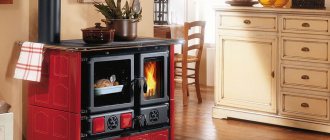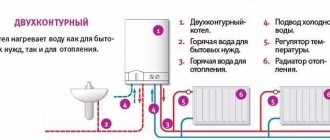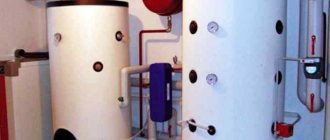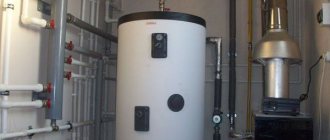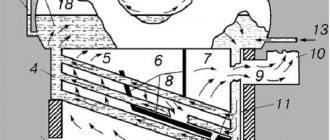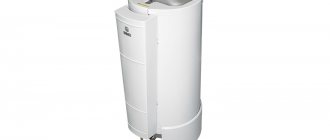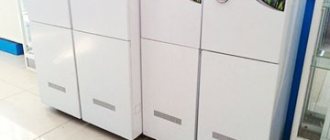Home / Solid fuel boilers
Back
Published: 08/10/2019
Reading time: 6 min
0
5298
Mine boilers (MC) with long-burning pyrolysis type or Kholmov boilers are one of the types of solid fuel heat generators. They belong to the class of energy-independent and efficient units, with forced or natural movement of the gas-air environment.
Typically, mine boilers are manufactured at industrial sites, however, today there are many designs made by hand by craftsmen in compliance with the requirements of regulations and standards in the field of manufacture and safe operation of boiler plants.
Many devices are equipped with energy-efficient features with an additional water heating circuit and storage tank.
- 1 Kholmov's boiler
- 2 The principle of operation of the boiler
- 3 Advantages and disadvantages
- 4 Manufacturing a mine pyrolysis boiler 4.1 Algorithm for creating a boiler with your own hands.
Kholmov's boiler
This modification of the stove is distinguished by the fact that it is equipped with two chambers - for installing a heat exchanger and separately for burning fuel. These devices feature bottom combustion and a full-height firebox, which became the name for them. The principle of operation depends on the design.
The most popular today are two designs:
- Kholmov pyrolysis boilers (PK);
- normal combustion.
The fuel burns at the bottom of the closed combustion space. The second shaft is smaller in size and is used to burn exhaust gases and cool them in the boiler for heating water.
Non-volatile devices control the temperature with an RT3 thermostat installed at the front of the structure. To ensure complete combustion of the fuel, the air supply to it is regulated by the blower door located on the main door of the ash pit.
Kholmov's boiler. Top and side view
A special restriction valve is installed to ensure minimal air passage. In the upper rear part of the unit there is a pipe for connecting a chimney that provides natural draft.
The boiler is equipped with a shut-off valve and compensators on the outside and inside the body, designed to prevent welds from breaking during emergency overheating.
Pros of top loading appliances
- High efficiency. In addition to the noted points, this is also due to the specifics of fuel combustion. In conventional TT boilers, the flame gradually engulfs the entire core. In analogues with top loading, it is of the so-called shaft type. That is, the combustion process directly affects only the lower layer of firewood (coal), while the upper part of the stack goes through the pre-drying stage. Actually, such boilers are just one of the types of long-burning installations. More information about the devices of this group can be found here.
- Ease of use. This logically follows from the first point. If for front-loading TT boilers it is necessary to constantly monitor the combustion process and regularly add coal or firewood into the firebox, then modifications with VZ relieve the user of this. The time savings are obvious.
- Energy independence. To operate the control and monitoring elements, the boiler does not need to be connected to the industrial/voltage network.
- Easy to use and care. As a result, maintenance and repair costs are disproportionately lower compared to more sophisticated analogues.
Operating principle of the boiler
The heat generation process occurs in two ways: direct combustion of natural fuel and afterburning of the pyrolysis gas mixture formed due to lack of air. Some of the fuel smolders, releasing smoke with tar and soot. Next, the gases migrate through the coals, becoming saturated with flammable components and turning into a gas-combustible mixture.
These shaft-type units have bottom combustion. The process is carried out at a level of 20.0 cm in the lower zone of the combustion chamber. The top fuel waits in the hot reserve until the bottom burns out. Flue gases are collected approximately 30.0 cm above the fuel.
The main volume of primary air falls under the grate and moves to the part of the unit for pyrolysis afterburning. It traps flue gases above the combustion level.
The shafts are separated by a partition with a small gap at the bottom, through which the flame is drawn by traction from the first chamber to the other, where complete combustion of flammable gases, washing the convection heat exchanger at T +850 C, is completed.
The heating circuit in the water jacket of a shaft-type boiler is subjected to radiation heating; the residual heat is transferred to a convection-type heat exchanger.
How to heat properly
To realize the benefits of a shaft boiler and increase the efficiency of heat transfer, two points are important: the quality of the fuel and proper installation. Hardwood (for example, coniferous) firewood contains a lot of resins, which accumulate on the walls of the chambers and reduce efficiency. Wood briquettes and pellets are easy to use, burn well, but their price is higher.
Ignition and adjustment of the boiler take a little time, but the quality of the unit’s operation depends on the correct completion of this stage.
Follow a simple algorithm:
- They put a little fuel on the grate and set it on fire, like in a wood-burning stove. After a few minutes, the flame flares up. When it becomes strong, the boiler enters operating mode.
- Reload fuel. The unit begins to operate in pyrolysis mode.
At least half of the stack should be dry firewood. Logs of high humidity are placed on top: by the time they burn, they have time to dry.
A common mistake made by users is incorrectly stacking firewood, which causes it to get stuck in the shaft. The boiler is designed on the principle of bottom combustion, so the fuel must lower itself to the heat.
To prevent combustion from being interrupted, the logs should be slightly shorter than the distance between the walls of the loading compartment. The firewood is laid across the shaft opening: then they can freely fall down.
Advantages and disadvantages
The mine unit has the following main advantages:
- Versatility, availability of work on different types of fuel, including liquid for modified installations.
- High boiler efficiency, productivity and autonomy without additional fuel loading up to 24 hours.
- A well-thought-out design that simplifies maintenance; loading/unloading is carried out through separate hatches.
- Reliability and safety, therefore, indoor gas pollution and carbon monoxide poisoning can be said to be reduced to “zero”.
The disadvantages include:
- increased soot and tar formation during fuel combustion;
- huge dimensions of the installation.
The best known manufacturers and models: characteristics and prices
Stropuva S15U
The well-known Lithuanian model with a power of 15 kW is essentially one of the best top-burning boilers for heating a private home. The S15U model, unlike the regular S15, is universal, i.e. capable of working on wood, coal, peat, pellets. The manufacturer recommends using coal as fuel. In practice, with a full load (217 l) of high-quality coal, the combustion duration can reach 7 days. Efficiency, depending on the fuel used, is 85-90%.
When burning wood, the boiler has significant disadvantages: high requirements for dry wood and a high level of tar formation on the walls of the firebox. Another disadvantage is the huge weight – 205 kg. Otherwise, according to installation practice and owner reviews, the boiler has been operating without problems for more than 7 years.
Cost: 81,500–101,770 rubles.
Boilers with a burning duration of one load of fuel up to 7 days
LIEPSNELE L20U
Another universal Lithuanian model with a power of 20 kW, an excellent analogue of the Stropuva - superior in characteristics, but also more expensive. The model is distinguished by one of the largest combustion chambers on the market - 320 liters, as well as high efficiency - up to 91%. The heat exchanger is cast iron, in a steel casing.
The boiler is known for its reliability, the quality of the alloys used and assembly, as well as its absolute “omnivorousness”: you can burn wood, sawdust, shavings, pellets, coal or even peat. However, it is worth remembering the combustion duration of each type of fuel. The longest burning time is achieved when burning coal: up to 7 days.
The only drawback is the rather low permissible pressure in the water circuit - 1.5 bar. Therefore, the boiler cannot be used in closed heating systems of large houses, where the pressure in the circuit is often in the range of 1.7-2.5 bar.
Galmet TOP-20
Polish universal top-burning boiler of standard layout with a power of 20 kW. It is distinguished by maximum automation of work: already in the basic configuration there is a smart PID controller (automation), a fan that pumps air into the firebox, and the ability to connect an external thermostat. Depending on the configuration, it is also equipped with weather-dependent automation (outdoor sensor). The model is also distinguished by the presence of high-quality thermal insulation, which minimizes heat loss through the boiler body.
However, despite the quality of materials and smart automation, unlike vertical mine boilers, it has a lower efficiency of 87%. The heat exchanger, unlike previous models, is made of steel, although with thick walls (6 mm versus standard 4 mm in other models), which in theory extends the service life to 15 years or more.
Cost: 89,000-90,900 rubles.
WEEK KO-60
Well-known model of Russian production with high power (60 kW). The name of the model speaks for itself - the duration of combustion on one load of coal is up to 7 days, with a combustion chamber volume of 160 liters.
Efficiency when using high-quality coal grades reaches 92%. Firewood, peat, and pellets can also be used as fuel. The heat exchanger and boiler body are made of extremely thick furnace steel, which is reflected in the weight of 420 kg. Despite the enormous heating output, it is rational to use the boiler with a heated area of no more than 200-250 m2. With a larger area, it is impossible to achieve a burning duration of 7 days.
A significant disadvantage is the extremely high price, comparable to foreign models of higher quality in terms of alloys, assembly and design. However, the boiler provides an excellent alternative.
Cost: 130,000 rub.
Manufacturing of a mine pyrolysis boiler
Today, modified PCs are in great demand, with high efficiency, allowing to save a significant amount of fuel and functioning from one filling for more than a day. The simplicity of the design allows the boiler to be manufactured with even little experience in welding.
Drawing of an ordinary pyrolysis boiler
The basis for creating an effective Kholmov boiler with your own hands will be reliable design documentation: drawings, specifications and calculations, which today can be found on the Internet.
When choosing the desired drawing of the unit, pay attention to the loading volume of the device; the larger it is, the longer the operation will be and what the power of the heat generator depends on.
Algorithm for creating a boiler with your own hands.
- They make the main part of the device and divide it into two chambers, installing partitions and valves for air supply.
- The diagram of the parts is transferred to a metal sheet and cut out autogenously.
- The side elements are welded using a reinforced seam.
- Between the boiler and the firebox, 2 holes are cut in the partition - at the top and bottom near the grate.
- Install the furnace parts and scald them.
- Place the valve at the top hole and secure it.
- Grate bars are made with narrow longitudinal slits cut.
- The grate bars are placed on metal corners (cast iron) or welded (steel).
- The doors of the firebox and ash pan are made.
- A boiler made of 25 mm pipes with a water jacket is installed and scalded.
- They set up an afterburning chamber for the smoke-gas mixture by welding a partition next to the grate.
- A hole is made at the bottom to install a 50 mm air pipe with a blind damper at the outlet end and many holes to create a uniform air flow.
- The combustion chamber is insulated with chamotte, and then it is additionally insulated with basalt wool, which increases the thermal efficiency of the boiler unit.
- Next, they install the manufactured equipment, connect the water and smoke gas ducts, install the heating, and then pressurize the system.
Tips and tricks for use
Before launching, tests are carried out: air is pumped under a pressure of 1.5 atm. Observe the seams, previously coated with soapy water, to see if there is any depressurization.
A fully loaded boiler reaches rated power in 20 minutes. An average of 3 kg of firewood is consumed within an hour. The duration of combustion in normal mode depends on the capacity of the hopper.
If the weather does not require high coolant temperatures, many units switch to smoldering mode. Manufacturers advise loading less fuel. Smoldering has a bad effect on the condition of gas ducts and the internal surface of the boiler.
Of all solid fuel units, mine ones are the most convenient, efficient, and unpretentious. For country houses, this is the best solution to the heating problem.
The best mine boilers
Pyrolysis-type ShKs are now in demand among the population living in one-story and two-story houses, since they have proven their effectiveness and demonstrated ease of operation.
The market responded quite quickly to customer requests and was filled with a wide variety of units from domestic and foreign manufacturers.
In online shopping ratings for 2022, the greatest demand is for units with a service life of more than 20 years and innovative heating surfaces.
Main characteristics of mine boilers.
| Indicators | Pyrolysis 43 Kp-10 | Heiztechnik (12 kW | Wirbel ECO CK Plus 25 |
| Price | 67100 rub. | RUB 215,760 | 277845 rub. |
| Model | 66694 | 90128 | 80023 |
| Manufacturer | Pyrolysis 43 | Heiztechnik | Wirbel |
| Short description | Duration of work on 1 tab is up to 10 hours. Efficiency 85% to 90%. Energy intensity, low fuel consumption. Automatic heating temperature maintenance. | Power 12 kW, new EU product, innovative technology. Eco-friendly heating installation with an advanced burner with auto-ignition and a self-cleaning system. Efficiency - 91%, heating temperature - 85 C. | Universal unit for liquid and solid fuels. Range of heated medium – 40/90 C, efficiency on solid fuel – 85%, on liquid fuel – 90% |
| Power, kWt: | 10 | 12 | 25 |
| Weight, kg | 210 | 350 | 271 |
| Dimensions (HxWxD), mm | 1070x500x800 | 1370x1150x550 | 1260x915x1070 |
| Chimney diameter, mm | 160 | 150 | 160 |
| Manufacturer country | Russia | Poland | Germany |
Thus, to sum it up, we can say that shaft-type boilers are efficient devices with low specific fuel consumption. Such units are used today for individual heating of residential and public buildings, significantly reducing owners’ heating costs.
How to choose a top combustion boiler
Due to the small selection, when all are worthy, there are no special criteria by which boilers can be filtered. Almost all models have a similar design, are often made of similar alloys, and both have a long history of trouble-free operation. However, it is worth paying attention to the most important criteria:
- Heat exchanger material . There are two versions: steel and cast iron. Steel heat exchangers are installed in cheaper models; they are more resistant to temperature changes; in case of mechanical damage, they can simply be welded. However, steel is highly susceptible to corrosion, which, depending on the quality of the coolant, leads to leakage after 10-15 years of operation. Cast iron heat exchangers are heavier and thicker, they are resistant to corrosion, their service life is more than 25 years, but the cost is corresponding. The ideal version is a cast iron heat exchanger in a light steel casing.
- Number of circuits . Single-circuit models are designed exclusively for heating. Double-circuit models are designed for heating and heating sanitary hot water. Their cost is only 10-30% higher, so it is most profitable to solve the issue of hot water supply by choosing a double-circuit boiler. The only problem is that among top combustion boilers there are very few double-circuit models.
- Efficiency . The efficiency factor reflects the ratio of the volume of fuel burned to the volume of thermal energy accumulated by the coolant. Accordingly, the higher the efficiency, the more heat can be obtained with less fuel consumption.
- Energy independence . Non-volatile models do not require connection to the mains, so they work autonomously. Volatile models have forced air supply, more complex automation or a circulation pump, the operation of which requires a connection to the electrical network. At the same time, we recommend purchasing a generator in case of a power outage.
The Nedelka K-60 model is an example of significantly larger dimensions.
Minimum required power
For an average house in the climatic zone of the Moscow region, with a masonry of 2 bricks and a ceiling height of 2.7 m, the minimum required power is calculated from the rule of 1 kW for every 10 m2 of heated area. We also recommend keeping a power reserve of 15-25%.
For example, for the house described above with an area of 120 square meters. m. the minimum required boiler power is 120:10 * 1.2 (20% reserve) = 14.4 kW, we always round up - i.e. 15 kW.
Such simple and most commonly used calculations are sufficient in more than 90% of cases. If the house is slightly or seriously insulated, is located in the southern part of the country or, conversely, is located in the northern part of the country, has a large glazing area, the indicator can be adjusted by 10-50% down or up.
How to accurately calculate the required boiler power Individual calculation, formula and correction factors
Case manufacturing
The body is the main element of a wood-fired mine boiler.
It is made in the following sequence:
- First, they study the drawings of the future unit in order to determine the dimensions of all its metal elements.
- Rectangles are marked on sheet steel with lining, which will become the walls and parts of a homemade device.
- Sheets of metal are cut into blanks. This must be done using autogenous welding.
- Next, the side walls are welded.
- In the sheet from which the partition between the combustion and heat exchange compartments will be made, two holes are cut out - one at the top, the second slightly above the level of the grate. In this case, the height of the other hole should be 3 centimeters.
- The workpiece is placed inside the body, placed according to the drawing and welded. A valve is mounted on the upper hole on the side of the combustion chamber, welding its base. On the other side, attach a neck having a depth of 4 centimeters.
- To make a grate, narrow longitudinal holes are created in a piece of steel sheet with a lining. This item can be purchased ready-made. But it must be made of lined steel. A cast iron product will not be suitable, since after a few months of operation of the unit it will warp.
- Then the grate is welded.
- Holes are made in the side walls for the ash pan doors and for cleaning the afterburner chamber, along the perimeter of which the necks are welded so that they protrude outward and inward by 6 and 3 centimeters, respectively. It is advisable to attach the neck to the hole in the afterburning chamber after the heat exchanger has been fixed.
- 2 rows of metal corners or corrugated pipes are welded to the inner walls of the thermal chamber. The top row is placed at a distance of 3–4 centimeters from the top. The bottom row should be at the level of the bottom of the afterburning chamber. These rows will be part of the water jacket. It should be noted that it should not be done around the pyrolysis chamber, since as a result the entire process in it will be disrupted.
- The heat exchanger is welded to the inside of the water jacket.
- The bottom of the afterburning chamber must be welded at the level of the grate. In this case, one third of it is made horizontally located, and the rest is raised upward at an angle, the size of which depends on the drawing documentation. The area located near the internal partition should be horizontal.
- A hole is created above the bottom for a pipe supplying air.
- Many holes are drilled in a pipe with a cross-section of 5 centimeters. Next, it is welded to the hole in the body so that it protrudes outward by 6 centimeters. There should be no holes in this part. A valve is attached to the end of the pipe.
- The walls of the combustion chamber are lined with fireclay bricks, adjusting the materials to the required dimensions. Its top is made of brick protruding inward. A hole is installed between the bricks to move pyrolysis gases. Do the same with the afterburner chamber.
Long-burning solid fuel boiler - pros and cons
In the absence of a gas main, there are not many alternatives to build a heating system. You can install a gas tank, provided that gas supplies are established in the region. You can use environmentally friendly, but expensive electricity by connecting an electric boiler. But what to do if such options are not affordable? Or are gas and electricity resources limited or non-existent?
A long-burning solid fuel boiler will not require significant installation costs from the owner and will provide a reasonable replacement for the listed heating methods.
Advantages:
- Easy to use. Traditional work with wood, pellets or coal does not require special skills. Cleaning up ash takes no more than an hour a week.
- Durability. Service life exceeds 10 years. A long-burning boiler is an unpretentious technique. A simple design, with careful operation, can serve for several decades.
- Ecologically pure . The afterburner ensures almost complete combustion of the fuel. Emissions of harmful substances are a natural product of combustion - processed as a result of photosynthesis.
- High efficiency . There are models on the market with a value of up to 90 – 95%. Minimum heat losses are ensured. Engineering solutions optimize the process of afterburning pyrolysis gases. The heat exchanger design is designed with maximum heat transfer to the coolant.
- Efficiency and economy . Modern equipment is not much inferior to gas analogues. The effectiveness of long-term burning reaches seven or more days.
- Reasonable fuel cost. Sometimes it’s the only possible one. Frees you from dependence on expensive gas equipment.
- There is no permitting documentation for installing the boiler. There is no requirement to conclude service agreements with gas services.
- A long-burning solid fuel boiler allows you to provide home ownership with hot water, if there is a second circuit. In addition, an indirect heating boiler will help expand functionality.
Flaws:
- Constant involvement of the owner . Despite the long combustion process from one load, sooner or later you have to return to replenishing the loading compartment with fuel.
- Regular cleaning . Probably the least popular maintenance process, it requires constant cleaning of ash. All that remains is to envy the clean gas equipment or electrical appliances.
- Separate room . You will have to allocate a separate room with good ventilation and a chimney. A long-burning solid fuel boiler for a private home usually has significant dimensions; it may be necessary to prepare a special installation site with a reinforced foundation.
- Maintenance of fuel stocks . Replenishment and preservation of fuel residues will require additional financial investments. Compliance with safety measures and maintaining a certain moisture content of the product also adds problems in resolving storage issues.
Solid fuel boilers for heating a private house
Basic models of long-burning boilers with a water circuit using wood for the home are distinguished by the material of manufacture, the design of the firebox, heat exchanger, chimney, and the method of loading and burning fuel.
A long-burning wood-burning boiler with a water circuit is equipped with a tubular (vertical) register or a jacket-type heat exchanger. The housing design virtually eliminates the possibility of water boiling in systems with natural circulation.
The solid fuel boiler is based on the principle of long-term and economical fuel combustion
A long-burning steel wood-burning boiler for home heating has low thermal inertia. The boiler circuit is made of heat-resistant steel and can withstand sudden changes in temperature and pressure in the system. The disadvantage of the material is its sensitivity to corrosion, which is enhanced by the temperature stress of the metal. The service life of a steel unit is 15 years.
The walls of the cast iron heat exchanger of a wood-burning boiler for heating a private house with radiators take a long time to heat up and cool down. The brittle alloy is not intended for critical changes in system operating parameters.
Solid fuel boiler in semi-automatic mode
The advantage of cast iron is due to the amorphous nature of the material against oxygen corrosion. The service life of a boiler with a cast iron heat exchanger, with proper operation of the unit, reaches 25 years.
The operating principle of a long-burning unit is forced, sequential, top-down smoldering of wood, which releases methane, carbon monoxide and hydrogen. Lack of oxygen slows down the rate of flame spread. Additional thermal energy is generated by combustion of flue gas. The flow of exhaust combustion products washes the surface of the heat exchanger at the outlet of the boiler. The design allows loading firewood once a day.
Table 1. Price of long-burning solid fuel boilers:
| Boiler brand (country of manufacture) | Price, rubles |
| Zota Mix – 32 (Russia) | 38700 |
| Stropuva Mini S8 (Baltics) | 58240 |
| Long-burning solid fuel boiler OROR N 412 (Czech Republic) | 51731 |
